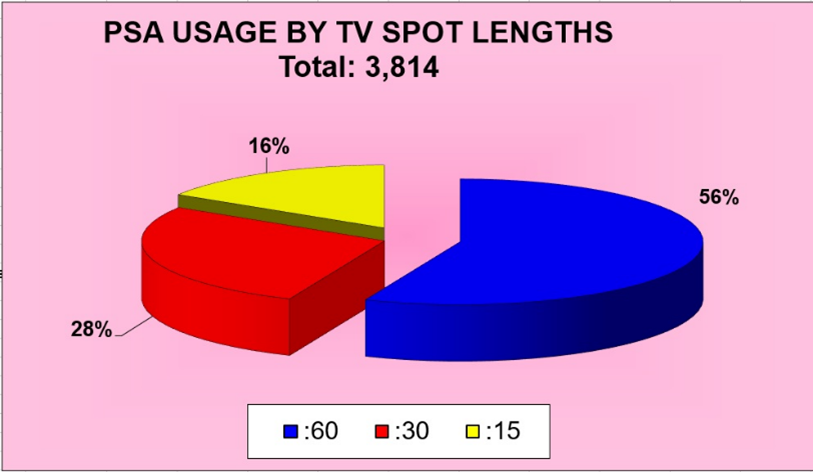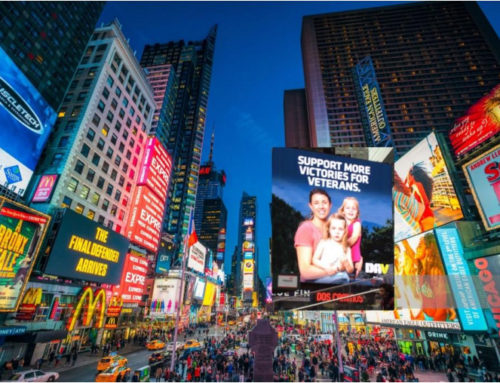Within the non-profit community there are those who are PSA veterans and those who are about to embark on their first public service campaign, those who team with professional organizations to plan, produce and distribute PSA’s and those who may have taken on this challenge themselves.
There’s no one set of rules to do it correctly. But, there are enough issues in trying to “get it right” that an overview like this might fit nicely into your “Save When Needed” folder. The perspective for this article is based on August, Lang & Hudak’s 12 years of experience concepting and producing successful PSA campaigns, and Bill Goodwill, of Goodwill Communications, the Agency’s partner for PSA distribution, tracking, and evaluation.
Major Challenges
Public service announcements are a vital tool in generating awareness for critical issues while dispensing important information for many non-profit organizations. PSAs, strategically created and distributed, can help to achieve organizational marketing goals in a very cost-effective manner while netting millions of comparable advertising dollars in free space and airtime. But, however enticing the promise of a great return on investment may be, it must be said that creating and deploying public service announcements is a major challenge.
Much has been written about public service advertising – delving into who uses PSAs, the message, the technicalities of distribution and evaluation and follow-up.
There are always opportunities to gain exposure for your cause, organization, or mission through public service advertising even if it’s not a campaign devoted to kids, health and safety, the most popular types of campaigns.
But just because you are a non-profit organization with a noble mission, it is not the media’s responsibility to volunteer their time and space to tell your story. To garner your fair share of exposure, you need to have message that connects, an execution that stands out, a marketing/promotion effort that separates your message from the pack, and a way to judge the impact of your efforts.
Premium Demand
The demand for PSA exposure is at a premium these days for several reasons:
- The emergence of many new social ills and causes accompanied by heightened public awareness and a renewed sense of activism. AIDS, drug abuse, the environment, illiteracy and the homeless are just a few of the most topical.
- Many TV and radio stations have become increasingly involved with local issues and select charities, meaning that those national issues without a local tie-in assume a lesser priority.
- In a race for greater audience shares, still other stations are using time that used to be allocated to PSAs for station and program promotions, to help them achieve a stronger identity in market.
 PSAs should be made with the same strategic focus committed to a commercial advertising campaign. You’re trying to grab the viewer’s attention, keep them from turning the channel, trying to dispense information and often, over the long run, trying to affect deeply seated attitudes and behavior. The job is much harder because you’re competing for time or space, not buying it.
PSAs should be made with the same strategic focus committed to a commercial advertising campaign. You’re trying to grab the viewer’s attention, keep them from turning the channel, trying to dispense information and often, over the long run, trying to affect deeply seated attitudes and behavior. The job is much harder because you’re competing for time or space, not buying it.
First and foremost, PSA ads in all media need to contain messages that provide information that is intrinsically useful to their respective audiences. Here are two examples from campaigns produced by August, Lang & Husak:
“Make sure you protect your ears from loud noises.” A PSA from the American Speech-Language-Hearing Association. This campaign was intended to assert the association’s role and relevance – yet the actual content of the TV spot, in order to pass network clearance as a bona fide PSA, needed to provide consumer tips on how to protect one’s hearing health. This nationwide public service campaign educated Americans about safe sound levels.
“Make sure your kids get enough exercise, so their bones develop to full strength later in life.” A PSA message from the American Academy of Orthopaedic Surgeons.
The purpose of this campaign was to position orthopaedic surgeons as the “go-to” physicians with skills that can keep you enjoying your highest quality of life. Yet, in order to qualify as a PSA and get on the air, this message couldn’t just be the AAOS talking about itself—but needed to contain helpful information viewers could use to maintain bone health.
Pitfalls to Avoid
As you move forward with execution of public service advertising, how do you create and produce a great campaign? Here are some of common pitfalls to avoid:
1) Your PSA message is ill-conceived. This mistake can come in several versions: a non-profit association that wants to tell the world about its own good achievements with plans of asking for donations. This is not a PSA. This is a paid commercial.
A different version: wanting to send a message that could only resonate with a non-profit’s own membership. Every PSA should make its own organization feel proud, but there’s a reason they’re called Public Service Announcements. The general public needs to take away something useful here – so “inside” messages conceived to appeal to a membership population don’t pass muster.
2) You’re not sure what you want people to do after they see your PSA. Volunteer for something? Change their personal habits? This is a common problem with PSA’s. Too many simply want to call attention to a dilemma – as if the viewing public didn’t have enough dilemmas to worry about. The usual wrap up – “For more information, go to reachout.com” – supposes that folks will suddenly be moved to get up and go do research about your cause and then become one of your champions. Doubtful.
If you want them to go to your Website “to find out more” it better be about something they can connect with instantly. Obviously, people with moles that are changing color would certainly take a moment to go to a Website about the warning signs of skin cancer. But without this strong vested interest, not many folks will flock to their computers simply “for more information.”
 3)There is a mistaken perception that TV stations only use shorter PSAs. According to Goodwill Communications, a leading marketing and distribution company for public service campaigns, “Longer length spots not only are worth considerably more in airtime; they also permit the communication of a longer message. This is particularly important if there is a call to action on the tag such as a toll-free phone number or website address because people need time to record the information in the spot. Our surveys show that just under 60% of all PSAs were sixty-second lengths.”
3)There is a mistaken perception that TV stations only use shorter PSAs. According to Goodwill Communications, a leading marketing and distribution company for public service campaigns, “Longer length spots not only are worth considerably more in airtime; they also permit the communication of a longer message. This is particularly important if there is a call to action on the tag such as a toll-free phone number or website address because people need time to record the information in the spot. Our surveys show that just under 60% of all PSAs were sixty-second lengths.”
4) Your approval process is not well defined. Who’s designated to approve creative — the scripts, rough cuts, and so on? This problem isn’t just confined to PSA ads, but can be especially troubling with PSAs because so many non-profits have large membership committees and other constituents who want to be involved.
This is critical: Make sure the people who have the authority to say “yes” are in key project meetings, and at the actual shoot. You’ll only torture yourselves and your agency if “approved” concepts and other decisions still need to get trotted down the hall to some sequestered officer who parachutes into the process at the 11th hour. Nothing good ever happens this way. Advertising does not get better as the committee to approve advertising gets bigger.
Things to Think About
So much for things not to do. Here are some key components of a public service effort that have a positive influence on the campaign.
 1) When producing your PSA, adopt a team approach by bringing all the people who will be involved in the campaign to the table in the planning stage. This doesn’t mean writing copy by committee, which normally results in disaster. It means that those who will be involved in various executional aspects of the campaign understand the objectives, audiences, timing, creative direction, distribution and evaluation.
1) When producing your PSA, adopt a team approach by bringing all the people who will be involved in the campaign to the table in the planning stage. This doesn’t mean writing copy by committee, which normally results in disaster. It means that those who will be involved in various executional aspects of the campaign understand the objectives, audiences, timing, creative direction, distribution and evaluation.
 2) Produce PSA materials for a broad media mix. Because each medium has different strengths and weaknesses in terms of reaching your primary audience, and since the timing, frequency and placement of PSA advertising can’t be controlled, it is important to use a broad media “mix.” When we target the general public with our campaigns we include all traditional media – TV, (including cable), radio and print. Our media planning efforts for any new PSA campaign always attempts to stretch the campaigns through opportunistic placements on the Internet and consideration of non-traditional media such as TO dioramas, bus and rail transit locations, interior mall signage and closed circuit television networks in chain retail stores.
2) Produce PSA materials for a broad media mix. Because each medium has different strengths and weaknesses in terms of reaching your primary audience, and since the timing, frequency and placement of PSA advertising can’t be controlled, it is important to use a broad media “mix.” When we target the general public with our campaigns we include all traditional media – TV, (including cable), radio and print. Our media planning efforts for any new PSA campaign always attempts to stretch the campaigns through opportunistic placements on the Internet and consideration of non-traditional media such as TO dioramas, bus and rail transit locations, interior mall signage and closed circuit television networks in chain retail stores.
3) Make it easy for media to use your materials. In order to maximize the chces of success make it easy for public service directors to use your campaign. Offer media targets maximum flexibility in terms of formats, sizes and lengths.
This means sending the media what they want and can use (appropriate video and audio formats), different spot lengths (a broad mixture as well as live and pre-recorded messages for radio) and outdoor posters in various sizes.
 4) Embrace diversity. Produce material to reach minority audiences. Remember our society is diverse in its composition, and that media targeting minority populations tend to be very supportive of causes that have relevance to their audience. Importantly, in-language versions of creative material have significantly increased the reach and impact of our campaigns.
4) Embrace diversity. Produce material to reach minority audiences. Remember our society is diverse in its composition, and that media targeting minority populations tend to be very supportive of causes that have relevance to their audience. Importantly, in-language versions of creative material have significantly increased the reach and impact of our campaigns.
5) Stay informed. Include in your planning process time to gauge the leanings of media gatekeepers. This insight, particularly among TV community affairs directors, should strive to identify trends in usage, their issue priorities, need for localization and other factors that could influence ultimate usage of your PSAs. This research can be conducted through random phone calls or by tapping into the expertise of a PSA consulting or distribution organization that should have a good idea which of their PSA campaigns are well received, and frequently used.
While much attention is given to the creative direction for the on-air, or in-print elements of a PSA campaign, a key challenge is to grab the attention of the media gatekeeper when launching a new campaign. Much like introducing a new product, you must strive to distinguish your campaign from every other PSA they receive.
In the new digital distribution era, you are somewhat limited in what you can send to the media, but alert cards, and custom emails with brief copy are appropriate.
Above all, make sure your PSA turns on a new light. So many PSAs deal with issues people are already aware of. Most folks already know what’s bad for them, who’s in trouble, how to stay safe, and so on. In order to take your message into their realm of awareness, you need to help them see your issue in a light they haven’t seen before.
 A perfect example is the now familiar anti-tobacco PSAs. After decades of telling kids that cigarettes are bad for them – showing black lung X-rays, patients on respirators and other shocking visuals – the new coalition realized that kids were not very dissuaded by this approach. Indeed, taking a health risk was part of the bravado of teen smoking. Instead, the new PSAs took the approach of telling kids that when they smoke, they’re playing right into the hands of devious tobacco company executives.
A perfect example is the now familiar anti-tobacco PSAs. After decades of telling kids that cigarettes are bad for them – showing black lung X-rays, patients on respirators and other shocking visuals – the new coalition realized that kids were not very dissuaded by this approach. Indeed, taking a health risk was part of the bravado of teen smoking. Instead, the new PSAs took the approach of telling kids that when they smoke, they’re playing right into the hands of devious tobacco company executives.
Now – instead of being brave renegades by smoking – kids are chumps who get manipulated by a marketing strategy. A profound and insightful adjustment – the kind of new light that moves minds.
Evaluating the Impact
Evaluating the impact of your PSA campaign and addressing options to improve the work are elements of the PSA effort that can’t be overlooked.
This is an area where the use of a professional organization to assist with PSA distribution, tracking and evaluation pays dividends. Any nonprofit running a PSA campaign should review regular usage reports that include information on when and where your ads have been broadcast or placed, what exposure has been generated for the campaign, and an estimated market value of the advertising received.
On average, the campaigns distributed by Goodwill Communications generate millions of dollars in multi-media support, depending upon the type of media used and the number of outlets targeted. That’s a significant return on investment on advertising awareness alone assuming a production and distribution budget of around $150,000.
 Getting feedback on PSA usage is only part of the evaluation process. The impact of the campaign must also be judged by the response to the campaign’s call-to-action. Tracking pre-post website “hits,” tabulating requests for collateral, or counting the number of toll-free phone calls generated via the campaign are just some of the ways responses can be measured.
Getting feedback on PSA usage is only part of the evaluation process. The impact of the campaign must also be judged by the response to the campaign’s call-to-action. Tracking pre-post website “hits,” tabulating requests for collateral, or counting the number of toll-free phone calls generated via the campaign are just some of the ways responses can be measured.
While there’s no published benchmark for the success of PSA’s for various causes, some examples of successful campaigns include a teen alcoholism PSA campaign that drew more than 76,000 calls to an 800 number providing information on local referral centers; an American Red Cross campaign “Play Your Part,” recruited 30,000 volunteers in one month, 14,000 of whom were from those hard to reach 18-34 year old’s; and, three other efforts handled for the National Institute on Aging generated just under 90,000 phone inquiries.

The diverse nature of cable television also provides the opportunity to more finely target PSA audiences by sex and age, and more and more by interest and hobbies. For example, boating safety PSAs are now appearing on fishing and outdoor life channels.
When adjusting the overall distribution effort, it is just as important to evaluate the promotional support behind the PSA campaign. An area that is often underutilized is the role local offices, affiliates or partners can play proactively contacting public service decision makers to promote the vital nature of a cause and the relevance of campaign.
Public service campaigns make up some of the most profound and powerful TV advertising there is. These spots deal with life-and-death issues. They urge us to think about people with desperate conditions, act to help those in need and support causes that can change the world.
Yet, given the current situation, the competition for donated media time and space is likely to get more intense. This, in turn, will force organizations to become more competitive, accept reduced levels of public awareness, or seek new methods of generating exposure for their issue. By developing PSA programs that combine focused strategic planning, hard-hitting creative, imaginative distribution and evaluation of results organizations can significantly increase their chances of stepping ahead of the competition and producing successful campaigns.







Leave A Comment